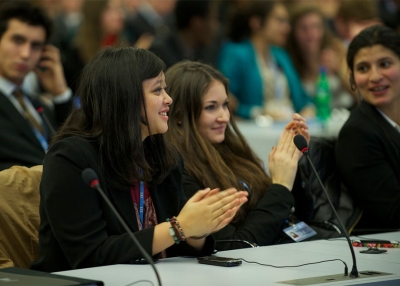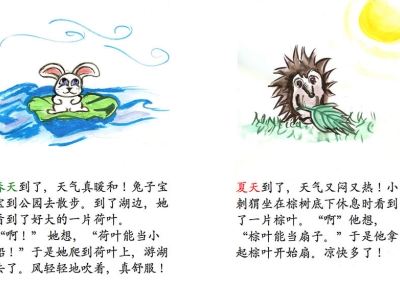The New Canons of the English Language Arts

Language shapes and reflects the human experience. In literature, in political speech and throughout digital media, language has the potential to spur people to action and deepen understanding of differences between cultures.
Taking advantage of this potential in an English language arts (ELA) classroom means a global focus that takes new approaches to the classics and uses new texts to open students’ eyes to different perspectives on global themes. To make sense of the role of language in the world, students must get the chance to explore multiple genres and text structures and generate their own responses and questions to what they read and hear.
Within a globally focused English language arts curriculum, students can develop their voice as writers, use a variety of communication tools for advocacy and create original material that reflects their understanding of the global community.
What it Looks Like in Practice
Global competence means understanding different perspectives and world conditions, communicating ideas in defensible ways, and recognizing that issues are interconnected across the globe. In English language arts, this means going beyond reading a classic piece of literature and writing an essay about it for the teacher to read.
To give an example, Asia Society schools anchor ELA curriculum on four global themes: identity, power, justice, and change. The themes are organized with essential questions to focus students’ reading and writing, and are interwoven throughout their language arts study.
In ninth-grade, students explore identity, learning to understand who they are individually and in their community, their school and the world. They read books about kids their age, compare and contrast experiences, discuss ethnic identities and holiday celebrations, and identify important people in their community.
Students examine power through what through personal explorations of what it means for individuals, what power is in the world, how it manifests itself, and who has it and who doesn’t. This theme is tied to the world history curriculum so students get the power perspective historically and as represented in literature.
The justice theme can be applied throughout an American studies course, and students look at social justice, what the word “justice” means, and whether it’s a universal idea.
The final theme, change, is explored in twelfth grade, as students look at the levers of change. What are the drivers of societal change? In what ways is communication a vehicle for change?
Reframe Literature
The themes are an essential part of creating a curriculum that helps students understand, analyze, evaluate, embrace, harness and create the written, digital, and oral communication necessary in the 21st century. But getting students to global competency in English language arts also means rethinking the canon of literature and using these themes to change the way it’s taught.
For instance, rather than introduce one novel at a time and look at themes and language within it, teachers can incorporate non-traditional texts to show students global issues from multiple perspectives, and offer them choices in the reading material. They take a global issue and look at how it’s represented in a variety of texts. For example, exploring the theme of parenting in the traditionally taught To Kill a Mockingbird, along with the not-so-traditional Purple Hibiscus, a Nigerian novel by Chimamanda Ngozi Adichie about a 15-year-old girl during a military coup. Students examine what parenting looks like in each novel, and what is universal and what is cultural about parenting in the world.
It’s important that students can see themes at work outside the classroom and in the world. For the novel Lord of the Flies, teachers can ask students to use a sociological lens, considering why the author chose to only have boys on the island. They can talk about how the novel would have been different if it was a group of girls, how a group of boys in their school resembles a Lord of the Flies group, and then what examples there are in the world, in other countries or cultures, that represent that social structure.
This approach to literary study helps students analyze and evaluate the ideas and arguments in texts, discuss an author’s style and use of language and put the text into context, culturally or historically. They learn to present clear ideas and recognize, understand and discuss different perspectives on a global issue.
Give Young Citizens Voice
It also sets the stage for action, the culminating piece of any global study that reflects what the students have learned. In English, students can create an advocacy project, taking an issue and using language to create something—such as a letter to the editor or a public service announcement on YouTube—that not only informs the public but moves the audience to action. They do this for not one, but multiple audiences, tailoring the medium to how it would best reach each one; for instance, they have to figure out what would convince a 60-year-old versus a 15-year-old, or someone in Brazil versus someone in West Virginia.
Students learn to use persuasive strategies for a specific purpose and audience, develop a clear position about a multi-faceted issue that calls for action, use language and multimedia to present their position clearly, and communicate confidently using digital technology and other tools. They also recognize that choices are related to cultural, societal and personal values and contexts.
What Are Your Experiences?
A globally focused English language arts classroom shows student who they are, and how they can have an impact on the world and influence the power structure. They become more powerful communicators, learning to sort through text with a critical eye, discerning what’s credible and understanding what drives someone to a particular speech. They find their voice as writers, learning the means to use words—in a story, letter, blog or video—that convince others to take action on a local, regional or global issue.
In doing this, students realize they have a global and community voice and can become leaders active in changing the world.
By Alexandra Moses, inspired by the work of Carol Mendenhall, Marjorie Larner, Adelle Barnett, Susan Marion, Karen Fernandez, and Stacy Webster.
Discuss: What do you do in your teaching practice that develop student global competece?









